
Meet the Juror

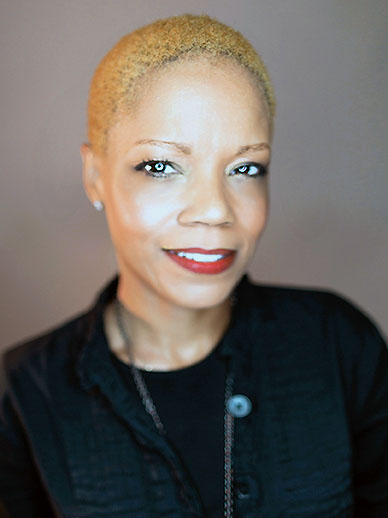
Rehema C. Barber Chief Curator for the Kalamazoo Institute of Arts (KIA)

For updates, follow AMUM on



https://www.memphis.edu/amum/

Juror's lecture with awards announced with Rehema Barber
This weekend, Sunday, April 18th, 2pm
Rehema C. Barber is the Chief Curator for the Kalamazoo Institute of Arts (KIA). Formerly, Barber was the Director and Chief Curator of the Tarble Arts Center at Eastern Illinois University and has also worked for various institutions such as: University of Illinois Urbana-Champaign's School of Art + Design (UIUC), University of Memphis, Memphis College of Art, Power House Memphis, The Amistad Center at the Wadsworth Athenueum Museum of Art, where she has taught and lectured extensively. Barber has been a participant in the 2018 Getty Leadership Institute, the 2012 Japan Foundation's Curatorial Exchange Program, the Getty Leadership Institute: The Next Generation in 2007, the Henry Luce Foundation Jewish Art Institute at NYU in 2006, and a 2001 Romare Bearden Fellow at the Saint Louis Art Museum.
Barber has written for various publications and blogs such as The Commercial Appeal, Fiber Arts, International Review of African American Art, Number Magazine, and Sixty Inches From Center among other outlets. In fall 2019, Barber contributed to the Shape of Abstraction: Selections from the Ollie Collection catalogue, published by the Saint Louis Art Museum, and contributed an essay, entitled "Picturing Freedom: The Legacy of Representing Black Womanhood," in The Routledge Companion to African American Art History, edited by Eddie Chambers. She also wrote for and co-edited the exhibition catalogue In the Eye of the Beholder, published spring of 2019. Barber holds a B.A. in Art History from Roosevelt University, an M.A. in Modern Art History, Theory and Criticism from the School of the Art Institute of Chicago, and a certification in Elementary and Secondary Art Education from the University of Missouri, Saint Louis. Currently, she is working on shows with Todd Gray, Yunfei Ji, and collaborating on an exhibition about constructions of masculinity in the 20th and 21st centuries with Larry Ossei Mensah. She is also a 2020 participant in the Art Writing Workshop sponsored by the Andy Warhol Foundation Arts Writers Grant and AICA-USA.


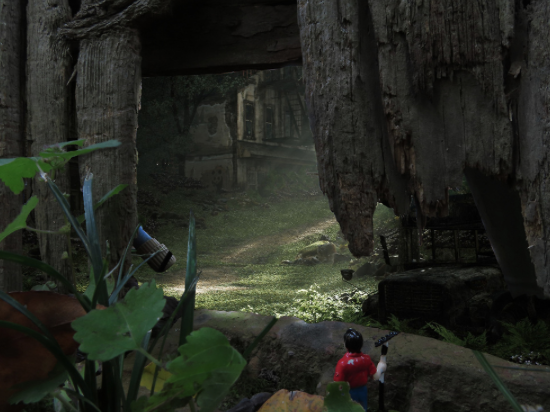
Green Envy
Kevin Zubovic
Photography | Adobe Photoshop
November 13th, 2020
97.222" x 72.958"
Artist Statement
This was a final that was a part of my 2020 fall semester of photography 1. This image came from a series 14 out of 14 which was a part of our “Tiny Worlds” assignment. The objective was to create a fictional world in whatever manner we chose. I’ve always been a fanatic of any media involving post-apocalyptic cities and environments, especially books and movies such as I Am Legend. The times we have recently found ourselves in also gave me inspiration as although society and structure hasn’t completely been abandoned, it can certainly feel that way at times, and so I wanted to create my own post-apocalyptic landscape alongside a narrative that follows the journey of a small figurine hoping to find some remnants of life. I took the photos of the figurine in a natural, outside setting, and I made sure to incorporate some sort of framing technique in each photograph in order to make the photoshopping easier and the end product a unique blend of real world and fantasy. In this image, the dark green tones are meant show the intimating dominance nature now has on the manmade landscape, while aspects such as the sunlight peaking in through the fence, aids in blending the foreground background. The cold sting of loneliness is felt as the dark corners hug the edges of the building and bus, yet the soft light shining in gives hope not only to the viewer but to the adventurer (figurine) who continues his search to find life.
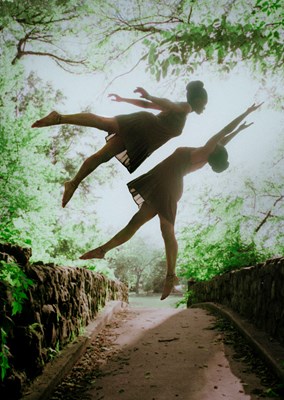
Fairies in Overton Park
Kristen Williams
Photography
2020
24" x 36"
Artist Statement
Hello, my name is Kristen Williams. I’m in the photography concentration program here at the University of Memphis. I am also a transfer from Memphis College of Art. I’ve been taking pictures since I was about 13-14 in junior high. I discovered my love for photography when I started noticing my attraction to outlandish editorial fashion ads I would see in magazines or on TV. I would think to myself “I want to create photographs like that too!” So, that’s how I got started creating my fantastical imagery. I would see these surrealistic photographs advertising fashion from people like Alexander McQueen, Betsy Johnson, Versace, Coco Channel, you name it. I loved how magical the photographs were. They were not just photographs, they were sculptural figures dressed for the places that they were in. Everything so planned and precise with so much attention to detail. I soon found out I had my work cut out for me if I wanted to create photographs like the great Cecil Beaton, Tim Walker, David Lachapelle, or Richard Avedon. They have whole teams helping them create their images. I am not quite there yet, but still, I do what I can to get the shots I dream about capturing. That’s where a lot of my ideas come from - dreams. Or lucid dreams. I have a hard time sleeping at night and when I do sleep I have wacky vivid dreams that leave me exhausted in the morning when I wake up. It’s a blessing and a curse. I do not think I could be as creative if it were not for the nonstop roller coaster that lives in my mind. My images are imaginative. They are colorful and bright.
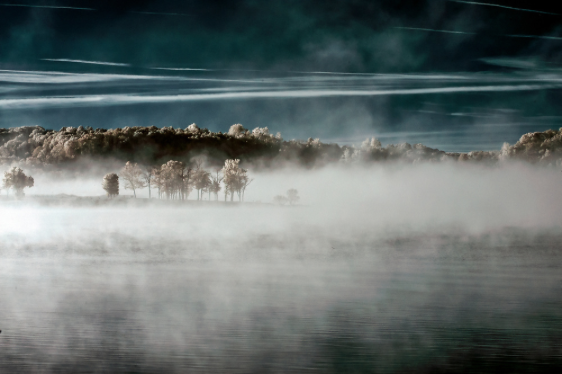
Mysticism
Mackenzie Schaaf
Photo Luster Paper
2020
60" x 44"
Artist Statement
Landscapes have always been incredibly important for me. However, after a recent bout with mental illness, landscapes have become my way of healing. The piece “Mysticism” attempts to show why landscapes are so important to me. Growing up I was surrounded by Ansel Adams photographs. Couple this upbringing with a family who’s roots are tied to the Cherokee people, and nature became my first form of spirituality. Growing up in modern Catholicism changed that view however, and only recently after my spell in a mental hospital I returned to my earlier spirituality I had grown up with as a child. “Mysticism” attempts to explore those themes with the use of fog and infrared technology to create an ethereal scene where the viewer is alone in nature.
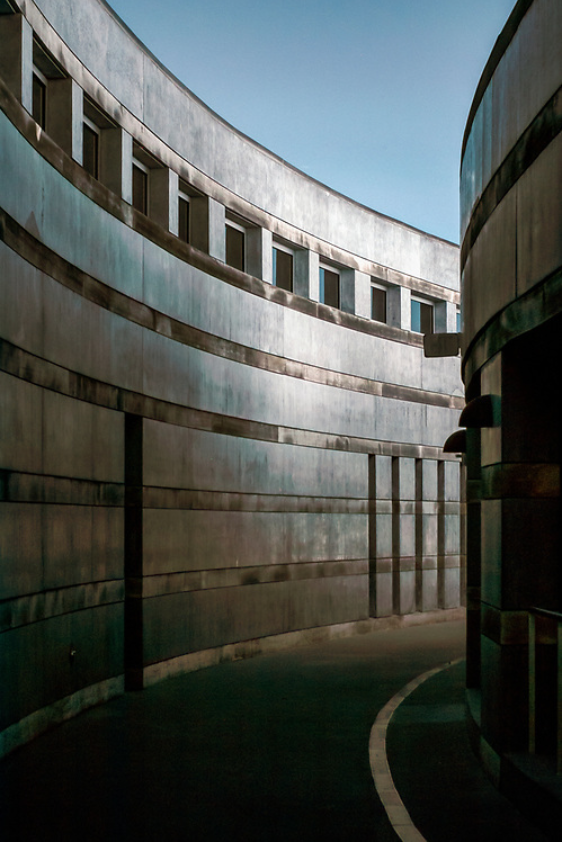
Monolith
Mackenzie Schaaf
Photo Luster Paper
2020
24" x 36"
Artist Statement
Architecture in my mind, is a forgotten art form, not in the sense that we have forgotten how to make interesting architecture, but in the idea that Frank Lloyd Wright may have been the last great artistic architect. During an independent study, I took a look at the comparison between modern architecture and older architecture, mostly looking at images taken in London, with comparisons like London Tower and The Shard, or the Parliament building and The financial sector. The uniqueness of each style of building had its incredible beauty. Upon returning back from England, I became increasingly away of that beauty, often searching for it wherever I could, either in the grandness of a cathedral or simplicity of an art gallery. “Monolith” however, leans more towards the side of modern architecture. The grand size of the stone walls that tower and surround the viewer create a sense of intimidation as they are guided down a winding path they do not know the end of. If only they knew at the end of the path was an art gallery waiting to be explored.
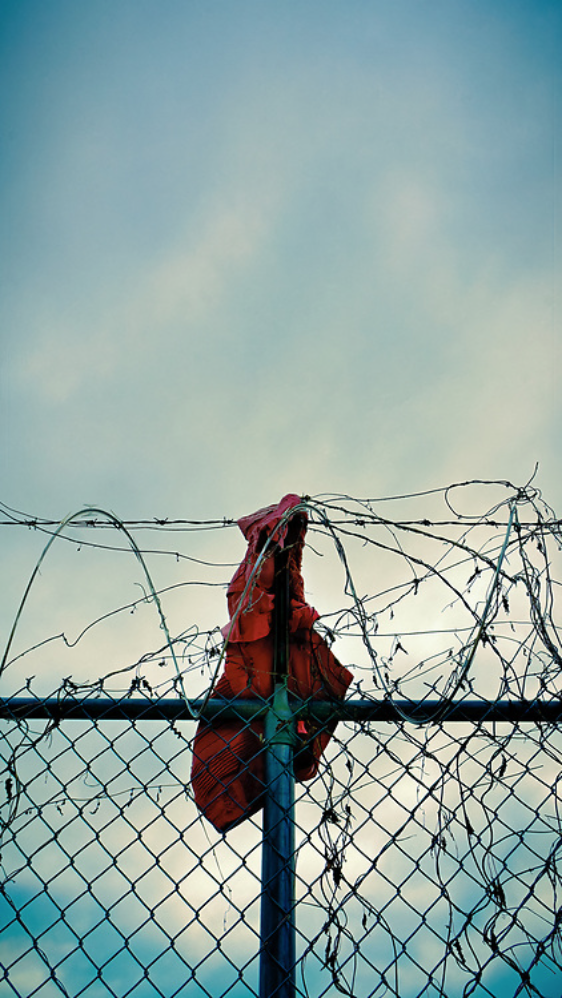
American Iconography
Anthony Presley
Photography
2021
15" x 28"
Artist Statement
American Iconography is part of a photography series where I capture the drastic changes Memphis is undergoing. Buildings are being torn down at a rapid pace, and new construction is being built in these locations. AI was located near one of these locations, and I felt compelled to capture the scene. Looking at the barbed wire fence with the red shirt and sky behind, I began seeing multiple icons and symbols through the imagethat corresponded with contemporary social issues.
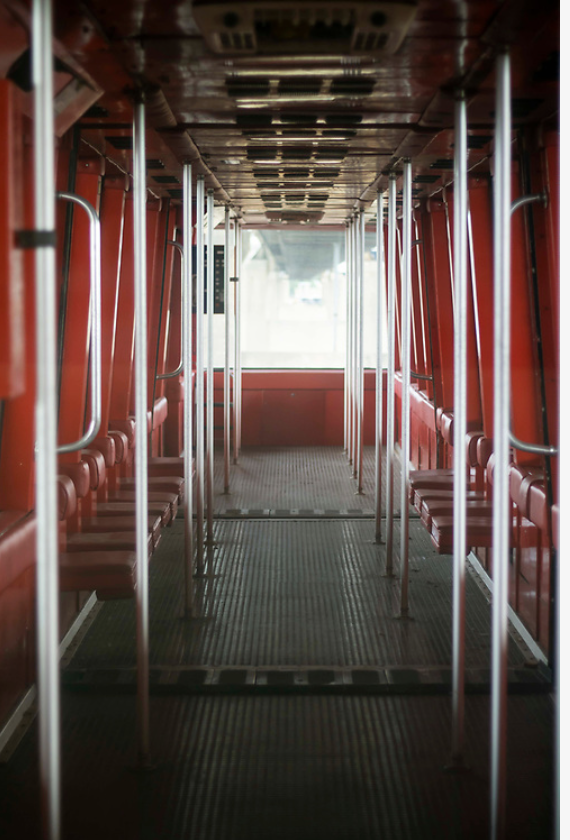
Vacant Monorail
Jonquil Lindsey
Digital Photography
2021
18" x 24"
Artist Statement
“Vacant Monorail” was captured this year as everyone was still subject to quarantine and social distancing. It felt like a good way to depict life in 2020 and 2021. The loneliness, the inability to go anywhere, and the lack of people being in public places is what was led to this image. There shows a peaceful stillness as the rest of the world stays dormant within their homes, but places like these feel less vibrant without the presence of people to occupy the space. The pop of color, satisfying symmetry, and bright highlights contradicts the current circumstances that may have effected many people in the last year and now. As the creator, it is fond to find the positives within the negatives.
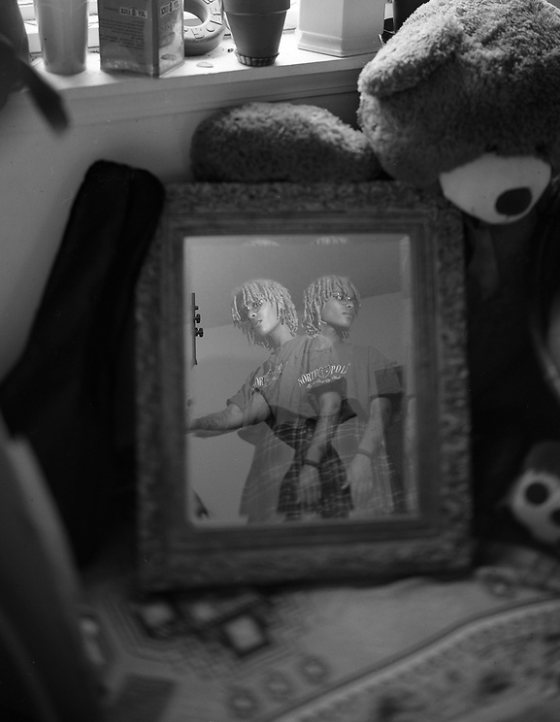
Mirrored Self-Portrait
Daija Guy
Photography + Edit
March 15, 2021
16" x 20"
Artist Statement
There are many moments that we humans don’t remember. It's almost like a dream that slowly fades away. These timeless moments where we grow, change, and become our truest selves matter and must be captured. Creating striking self-portraits that show how I am growing, changing, and transforming into my truest self. The images are dreamlike symbolizing how I feel and experience the world.
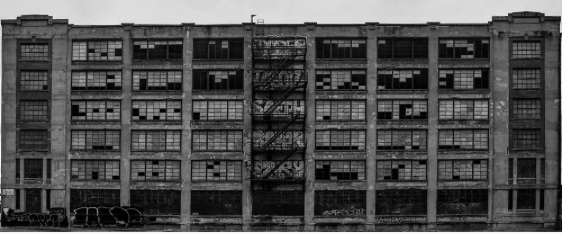
United 54
Alexis Coleman
Photography
September 30th, 2020
7.833" x 19" x .1"
Artist Statement
Urban decay is natural, especially in a city as old as Memphis. Locations subject to urban decay are generally considered abandoned and are often thought of as an eyesore, if not totally forgotten. While urban decay may be seen as a failure of the system to keep up with the changing times, I see it as a unique opportunity to record buildings and other locations crumbling under the weight of time and decorated with street art before they are gentrified or destroyed through other means. United 54 is an image of the long abandoned United Warehouse located on E. H. Crump Boulevard and Kentucky Street. This image was created by stitching together 54 individual photos of the exterior of the building. The original image is 10 feet by about 4 feet in order to fully show detail on the building, but due to print limitations the image presented has been shrunk down. Waiting is an image of a friend, a civil engineering major with similar interests in urban decay, leaning against a neglected barrier covered in graffiti across the train tracks from the United Warehouse. Waiting is a part of a series of images I took during the Spring 2020 semester when I began experimenting with images of urban decay and candid photography. The series of images with my friend explore urban decay around the Memphis area as well as graffiti, and new and old structures.


3 Hours and 12 Minutes
Anthony Presley
Digital Video
April 2021
4K 2160 X 3840
Artist Statement
3 Hours and 12 Minutes is an ongoing video project that invites members of the LGBT community to sit in front of the camera and have their emotions captured as they listen to an audio file. The subjects were not given instruction or warning as to what the audio is about in advance to record authentic emotional response. After one subject’s recording is complete, another subject comes on screen and goes through the audio recording. The total duration and title of the piece, 3 Hours and 12 Minutes, references the total time of the Orlando Pulse Shooting, where 50 members of the LGBT were murdered and 58 were injured.
Obsessive Compulsive
Jessica Johnson
Video Installation
December 2020
Artist Statement
My work over the last few years has developed into something more personal. As I navigate through life’s challenges and discovering that through mental illness, my perspective has shifted. I went from approaching my work for aesthetics only to develop it with a better narrative. Most of my ideas come from intrusive thoughts anyway, so I’ve decided to flesh them out a bit more. I want to give them a narrative and produce them as they are. I put together a video installation to illustrate how intrusive thoughts work for me. It is of one running shot of a person outside with overlapping flashes of intrusive images and audio of phrases/sentences/questions. It is on a continuous loop.
Unknown Exploration (Part 1)
Gustavo Espino Dorado
Video
March 2021
Artist Statement
This is part of, and the opening to, a larger animation project. As this was my first time exploring animation, the goal of this portion was to grasp the concept of motion within it. I felt that it was better suited for me to start by using tools at hand rather than digital means, as I felt that this would allow me to better visualize and experiment as I went with the concept. Therefore, the project contains elements such as drawing, collage, cut-out paper, in-camera photographic techniques and painting. As the project evolved, it became a matter of intuition of how I felt the project was evolving, as I made edits in time as I captured each sequence rather than edit afterwards. Further exploration was applying audio and try to achieve a feel toward the sequence as well as unify the piece. The end result for this part was a complete thirty second sequence that I felt could be open for interpretation and criticism, as well as for continued exploration, conceptualization and technical approaches that might be applied later.


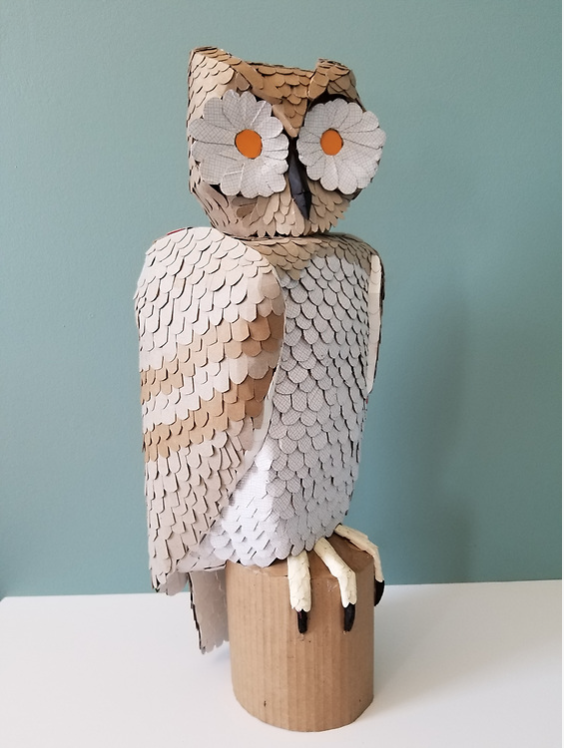
Cardboard Owl
Daniel Twedt
Sculpture
February 2020
20" x 8" x 8"
Artist Statement
Hey! My name is Daniel Twedt and I enrolled at the University of Memphis as an art novice, having recently retired from a 30+ year career as an ornithologist. I previously had an introductory art class as a college freshman, but that was in the early 1970’s. Needless to say, I have forgotten whatever I had learned nearly 50 years ago! Thus, eager to polish any latent artistic skills that have lain dormant, I tackled projects in beginning ceramics and basic foundations courses. I have enjoyed the creative atmosphere I have found at the University of Memphis – despite the limitations imposed by online learning. I look forward to more advanced classes, on campus, in the future.
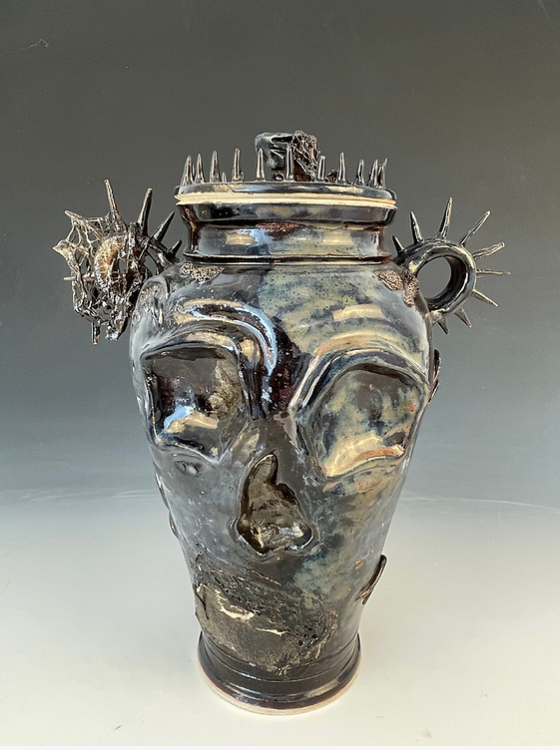
Death Urn
William Lescheck
Sculpture
January 14 2021
15" x 10" x 9"
Artist Statement
William Lescheck is currently working and selling his work at Belltower coffeehouse and ceramic studio. There he creates his work alongside Belltower’s own wholesale orders to businesses around Memphis. Along with creating, he also teaches classes for new people to experience the creative joy of ceramics. Mr. Lescheck was a Ceramic and Sculpture alumni from the University of Memphis in Memphis, TN. Being raised in the small town of Selmer Tennessee, he graduated from McNairy Central Highschool where he started to create art. He graduated from Jackson State Community College with an Associate Degree in Fine Arts, and went on to get his Bachelor's Degree at The University of Memphis. While he was obtaining his degree he participated in exhibitions and sales across Memphis, from Crosstown Sculptor Student Exhibition at Crosstown Concord to participating in The Memphis Potters’ Guild Sale at Saint Anne Catholic Church.
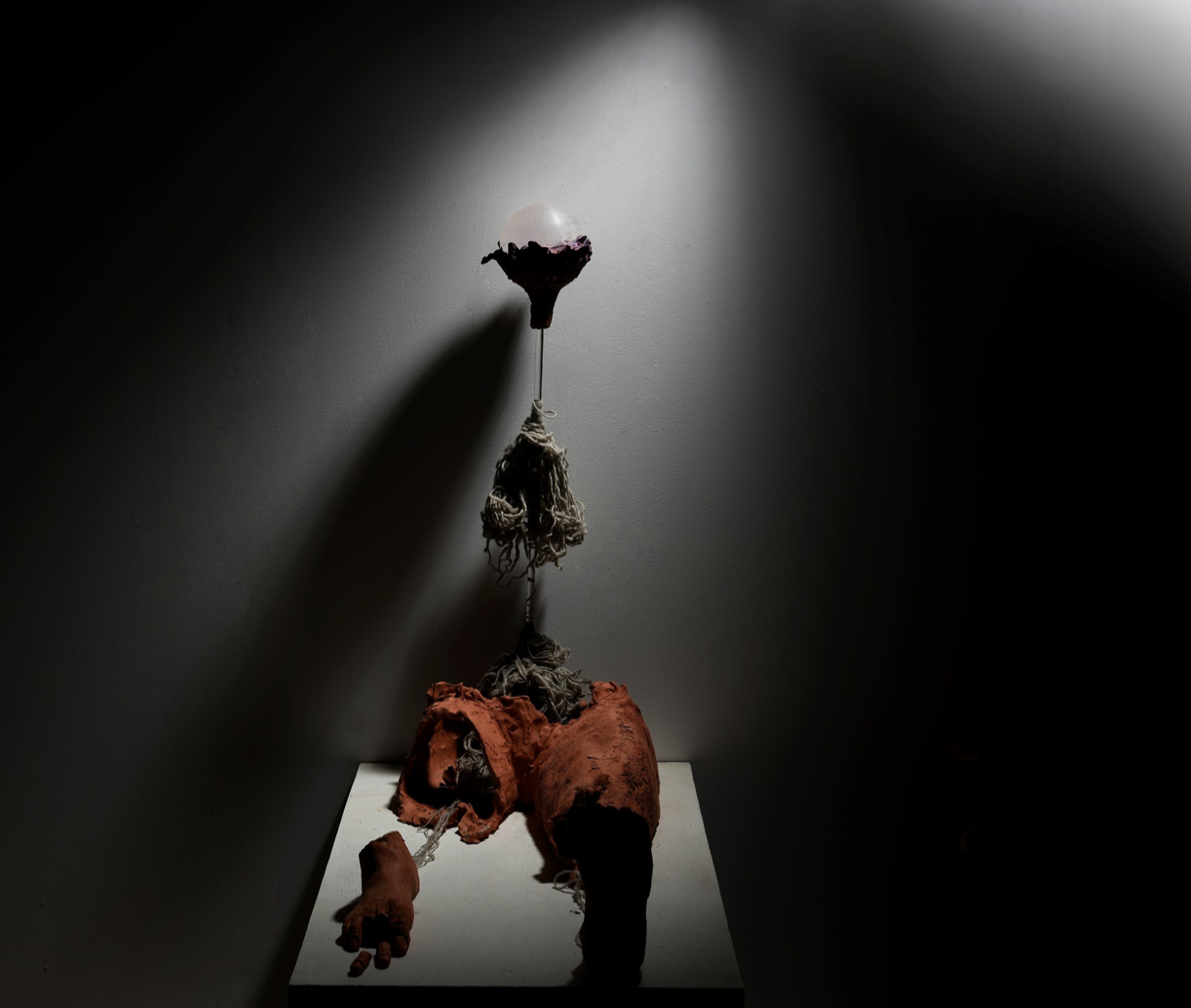
The Body
Rachel Davis
Ceramic, wool, projected light, & resin
2021
4ft x 2ft x 3.5ft
Artist Statement
The Christian church is referred to in numerous Biblical passages (1 Corinthians 12:12-31, Romans 12:4-5, Ephesians 4:16) as the metaphorical ‘body’ of Christ in which each member is an integral and unique part. Ephesians 4:16 states that “When each part is working properly, it makes the body grow so that it builds itself up in love.” My work examines the implications of this metaphor and what it says about our duty as believers individually as well as in the context of our community. This body of work detaches itself from a ‘one size fits all’ spiritualism and instead focuses on specific Christian theological issues surrounding baptism, the metaphorical body of the church, and our relationship with the secular world. The physical nature of the work allows viewers to contemplate these ideas from a distance and creates a space in which they can be discussed objectively. Materials such as fire, water, and clay (earth) are used to portray the physical realm while light is used to express the spiritual, heavenly realm. The fragile connection of the spirit and the flesh is captured in specific moments of proximity and distance between light and physical materials. The work exists as a reaction to today’s culture and increasing shift towards generalized moralism.
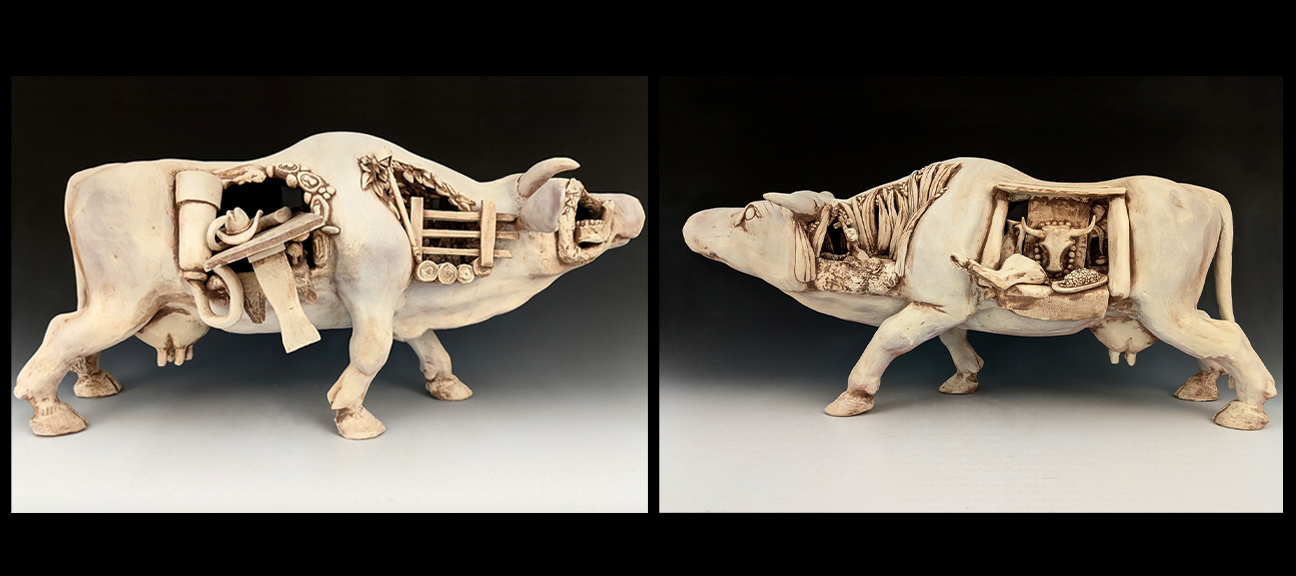
Until They Come Home
Becky Blackburn
Stoneware, chalk paint, locally sourced topsoil, red iron oxide, Fired to cone 6 oxidation.
November 2020
16”T x 19.5”L x 6”W
Artist Statement
My work is a record of the mutual history of humanity and animal kind. Each figure contains windows into the different chapters of that story, focusing on the many ways each has been effected by the other. In this way the work serves as a visual record of how domesticated animals and wildlife have played a role in bringing humans into the modern world.
Artist Bio
My name is Becky Blackburn, and I am currently in my final semester of grad school here at the University of Memphis. I grew up in the rural area near Prague, Oklahoma and have always been fascinated with history, animals, nature, and art. I received my BFA in ceramics from the University of Arkansas, Little Rock before attending the University of Memphis.


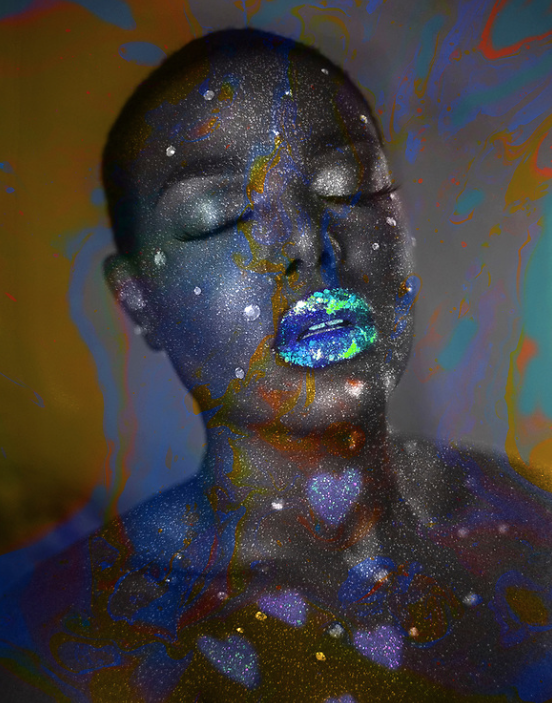
MOOD
Jasmine Smith
Digital Art
February 6, 2021
5792 px x 7372 px (72 ppi)
Artist Statement
We are our ancestors' wildest dreams, and we deserve to be here like everyone else. It can be very hard to love yourself in a world that does not always love you. Self-love is very important in everyone's life. There is no reason to seek validation from others on how you choose to live. Your only job here on earth is to live the life you want freely. Promoting the beauty of melanin skin with the use of star overlay. Colorism is within the community has tainted our views on the hue of melanin skin. No shade is more appealing than the other. Each one is divine and beautiful all the same.
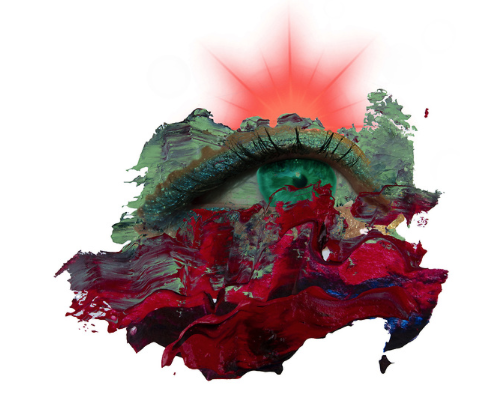
Sunrise
Reanna Ruddick
Photo Collage
March 2021
2560 x 2560px
Artist Statement
Color is the most important factor in all of my work. I obsess over the way different colors interact as well as their ability to determine an overall tone. My use of color is often meant to abstract the scenes I create. Allowing for the viewer to create their own visual based on their interpretation. People are more likely to remember a piece they connect with so by allowing the viewer to interpret the piece they add their personal touch. Instead of telling the audience what they are looking at I encourage them to determine what the art means to them. My most notable inspirations come from nature and the way I see the world. Many artists have also inspired my works such as Claude Monet and Paul Cézanne. Their ability to lead with their emotions and create beautiful atmospheres is something I strive to accomplish in my own work.
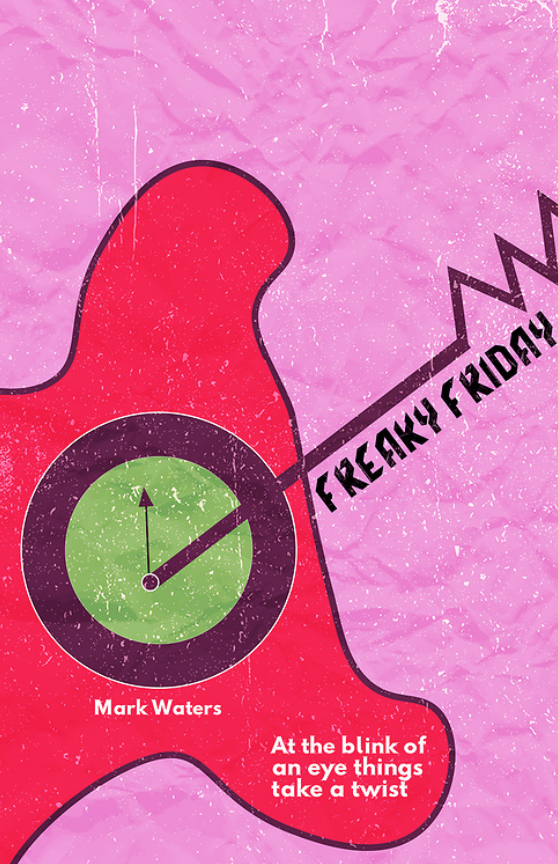
Time Flies
Lisa Lofton
Digital Illustration
2021
91.667" x 141.347"
Artist Statement
The objective of this assignment was to select a favorite film of our choice. After selecting the film we were tasked to create a poster based off the film using symbolic representation. My name is Lisa Lofton. I was born and raised in Memphis, Tennessee. I am currently a senior Graphic Design major student at the University of Memphis.
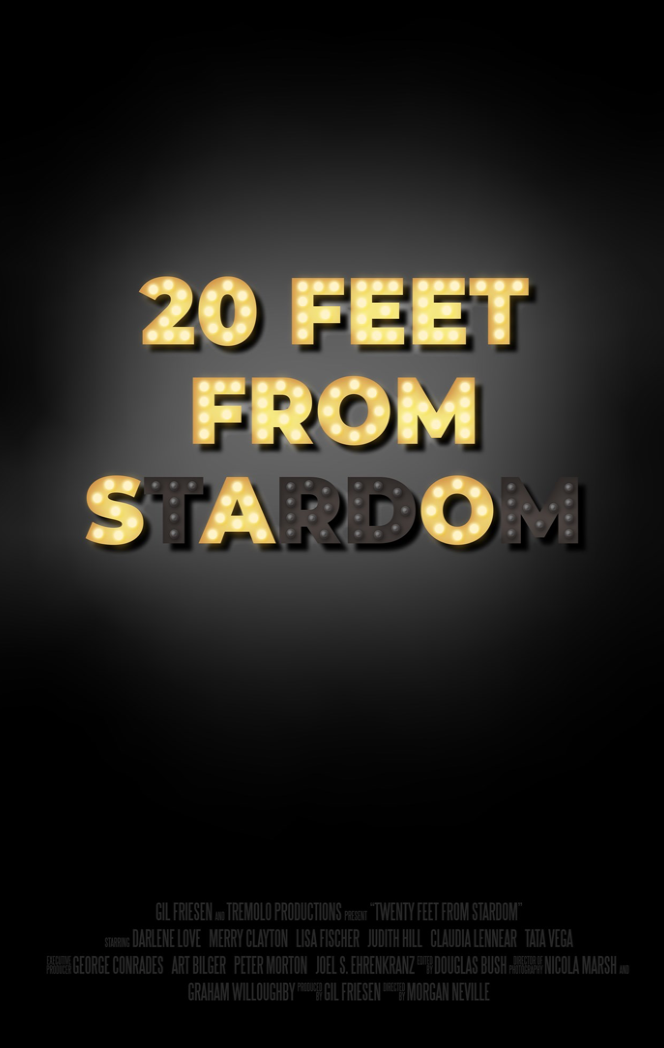
20 Feet from Stardom
Lizzie LaFont
Digital
Fall 2020
18" x 24"
Artist Statement
2O Feet from Stardom is a documentary film highlighting the importance of background singers like Darlene Love and Merry Clayton and their profound impact on the music industry. Although many were close, most of these singers never quite made it to the spotlight. Through the use of metaphor, this poster is meant to convey that very idea. Even with talent arguably greater than those for whom they were singing backup, they never got to see their own name in lights.
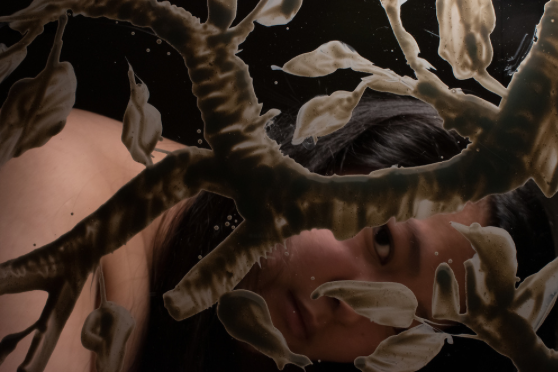
Branching Out
Emily Ellis
Porcelain, glass, digital media
2021
14" x 19"
Artist Statement
As a child who was often indoors and isolated, I was encouraged to find activities that could occupy a single person. Mom taught me how to read by the age of three and this gave me a foundation to escapism and understanding the world. Books have profoundly impacted my development as a person and artist. My love of books introduced me to a wide range of illustrators and I devoured images as eagerly as I consumed words. Today, I continue to cherish works such as Animalia, Little Bear, and the "Dinotopia" series, by Graeme Base, Maurice Sendak, and James Gurney, respectively. Throughout the years I have been inspired and enchanted by the quality of the work of artists like Norman Rockwell, Edward Hopper, John Singer Sargent, Frida Khalo, Clare Twomey, and Alphonse Mucha. The skill these artists have in attention to detail, world-building, introspection, and forging human connections motivate my own studies and artistic pursuits. I want to make art that can emotionally and physically entice and engage the viewer and this is one of the core reasons I am moved to create. Through this work I investigate themes of absence, loss, narrative, and how memories and self are perceived, across multiple mediums. The most recent body of work is based on the tenuous relationship that exists between the self I present and the self that is hidden. The conditions of my life fostered observational skills; this desire to depict the world was encouraged by the people that came in contact with my early work. Never having lost this desire, I embrace attempting to translate what is internal and unspoken.


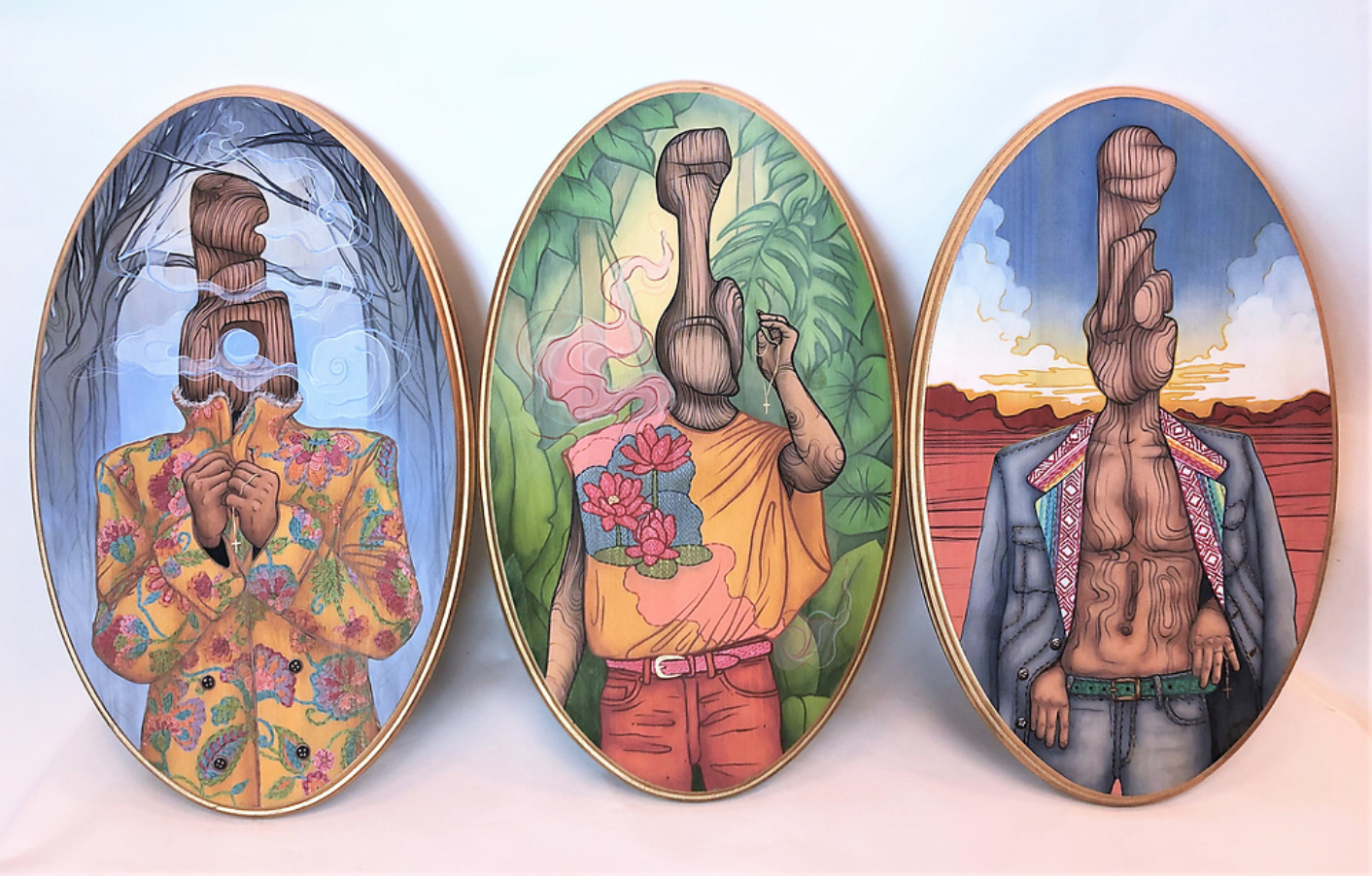
Here to Save Triptych (Ghost, Sonny, and Padre)
Danielle Sierra
Acrylic on wood
2020
20" x 36"
Artist Statement
My paintings focus on people and flowers. They are inspired by my experience with biblical concepts seen through a lens of allegory in a pop-surrealist style. I seek to create connection through the presentation of the human figure and propose intrigue through the costumes my figures wear, the flowers they are surrounded by, and the settings they exist in. They are stylized to become illustrations of the concepts they represent. Alongside the figures and in the flowers themselves I utilize the language of flowers to create a dialogue with them and the viewer. My work is aesthetically influenced by a catholic background but in rejection of that ideology of institutionalization non-reflective of what is found in the Bible; thus I attempt to create my own contemporary iconography in narratives inspired directly from scripture instead of religion through these paintings of people and flowers.
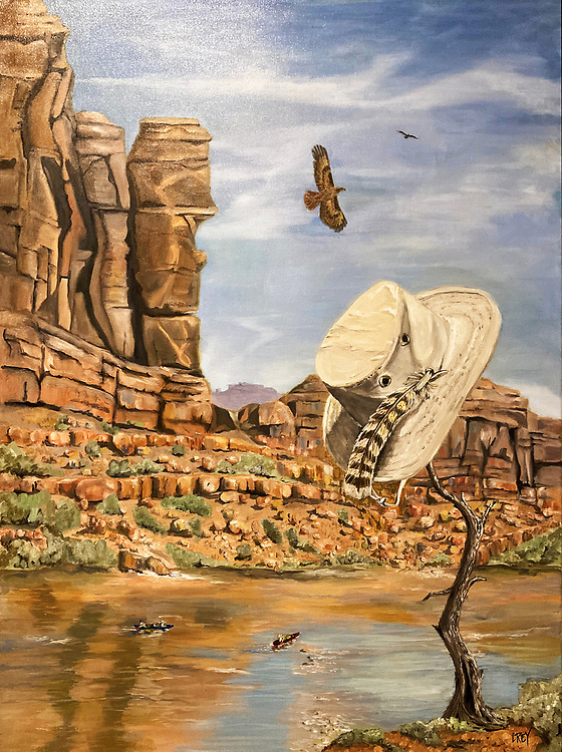
A Feather in Her Hat
Linda S. Reyle
Oil on canvas
November 2020
40" x 30" x 1 3/8"
Artist Statement
To the casual observer who experiences life indoors and virtually, the grandeur of nature calls us outdoors to actively engage with the world. From a high pinnacle along the Gunnison River in Colorado to the forest floor along the Wolf River of West Tennessee, nature entices us to explore the textures of rocks, the sounds of walking in a forest, the complexity of plant/animal/insect life, and the silence of solitude. With equal but different grandeur, outside is as close as a step out the back door and into the garden where nature comes to you. Put on your hiking boots and let’s get exploring.
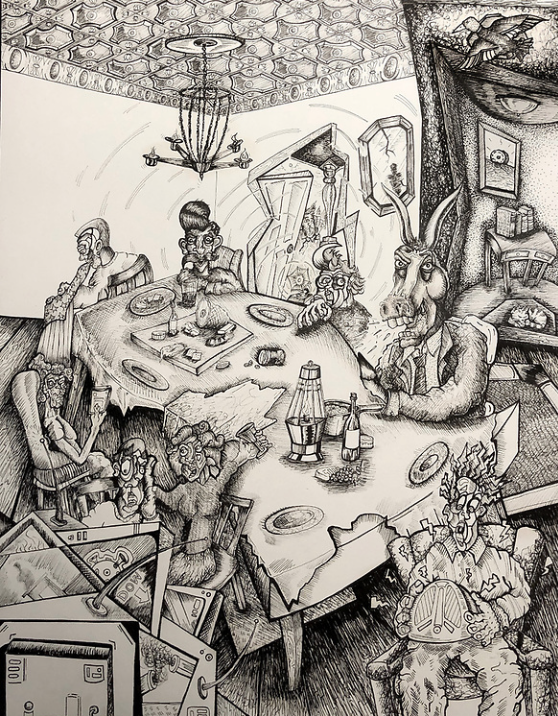
Their Divided Attentions
Clay Palmer
Ink on Paper
2020
14" x 11"
Artist Statement
The work in The Company We Keep is a series of paintings and drawings that examines contemporary Southern life through interior genre scenes. In these densely packed compositions, the anxiety of living in a period of history that harkens back to the post-Civil War South continues to ravage the region through ideological, economic, and socio-political strife. The instability of these domestic interior spaces reflects the interiority of the body in a state of panic. Items that serve as signs and symbols of poverty and wealth are placed near each other to bring attention to the fact that Southern middle-class families exist in a state of constant flux between these two poles. The turmoil and frustration of living within this context is further expressed through the manipulation of the forms that construct figures and interiors in a jarring, dramatic manner that takes influence from the social caricature of postwar German expressionism. The twisting and turning of furniture such as the kitchen table, a traditional gathering place for Southern families where ideas and values are exchanged, becomes a barrier that serpentines through the composition, keeping objects of sustenance and inequity just within or out of reach. Many of the works bear close compositional relationships to merry company paintings, a subset of Dutch genre paintings from the 17th century that contained clear moralistic messages regarding excessive lifestyles. The use of classic tropes involving mirrors and characters that acknowledge the viewer blur the lines between spectator and participant, leading the viewer to question to what extent and by what parameters that they participate in the othering of individuals based on social, economic, and physical characteristics.
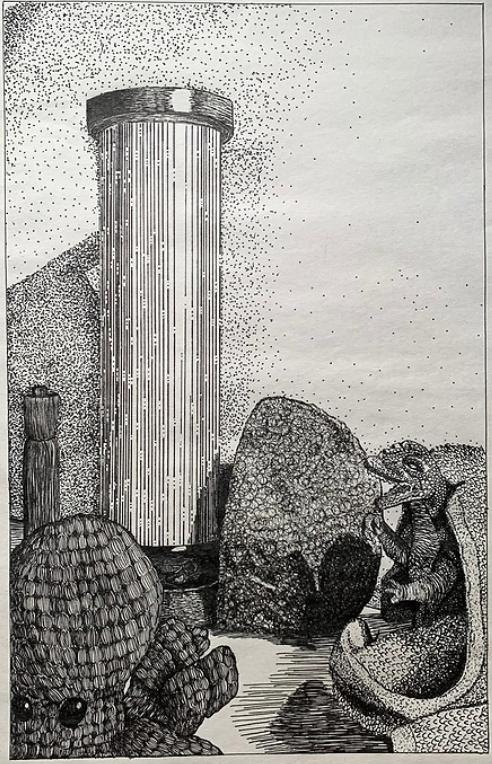
Texture and Value Still Life
Samantha Metoyer
Micron Pen on Newsprint Paper
February 12, 2021
12" x 18"
Artist Statement
This still life was created to show various types of texture and value. Each texture had to be unique with each item and distinguoshable to the eye. The medium of choice was an 08 and 05 Micron pen on a 12x18 inch sheet of newsprint paper. The items I chose in this environment are a highlighter, wooden kaleidoscope, Godzilla planter, painting rag, crotcheted octopus, and a geode. Each item was specifically chosen because they are all things that make me happy and serve some sort of purpose in my life.
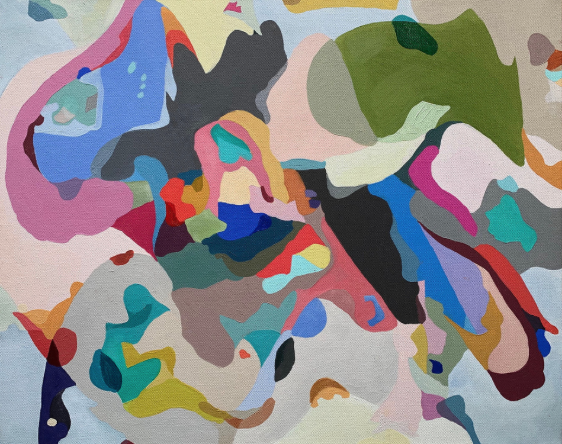
Vitality
Becka Matthews
Oil on canvas
2020
16" x 20"
Artist Statement
I am a senior studying Art with a concentration in Art Education, and after pursuing my degree I hope to become a high school art teacher. Growing up, I always loved art and school, and the two things have become almost synonymous with each other as they are such closely intertwined parts of my life now. I am drawn to colors that feel youthful and jubilant, and I am fascinated by the naivety and beauty found in the art of children who enthusiastically create without the worry of perfection or opinions. When other areas of my life become rigid, stressful, and overthought, I find great freedom in creating work where I can rely on my instincts and go with my gut rather than with my head. Because of this, my process is very intuitive, and each decision is a reaction to the one before it.
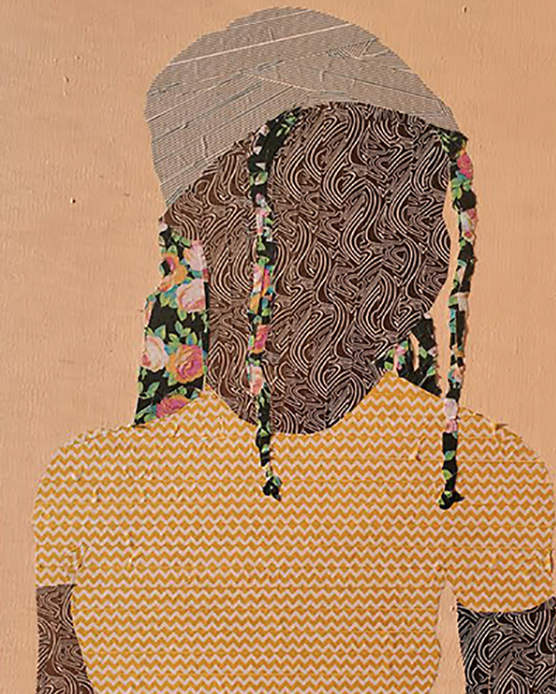
Untitled
Cheriyah Hill
Washi Tape
December 2020
16" x 20"
Artist Statement
My work is centered around portraits of family and friends. I get old and new photos of them towork with. From these photos, I portray their personalitiesthrough color and pattern. I alwayskeep the backgrounds blank because I want the mainfocus to be the subject. I make this work tointroduce the world to the people that I care aboutthe most. I use different patterns that I feelrepresent my family and friends to show who they areas people. I carefully choose the patternsfor the skin, hair, and clothes so I can leave hintsabout them. I also create texture throughlayering so the audience can walk up close to my subjectsand study them. I want the audience tofigure out who they might be and what their natureis so they can learn about them.
Short Bio:
My name is Cheryiah Hill. I am 20 years old and I am originally from Mississippi. I am currently a junior at the University of Memphis. My major is art with a concentration in graphic design.
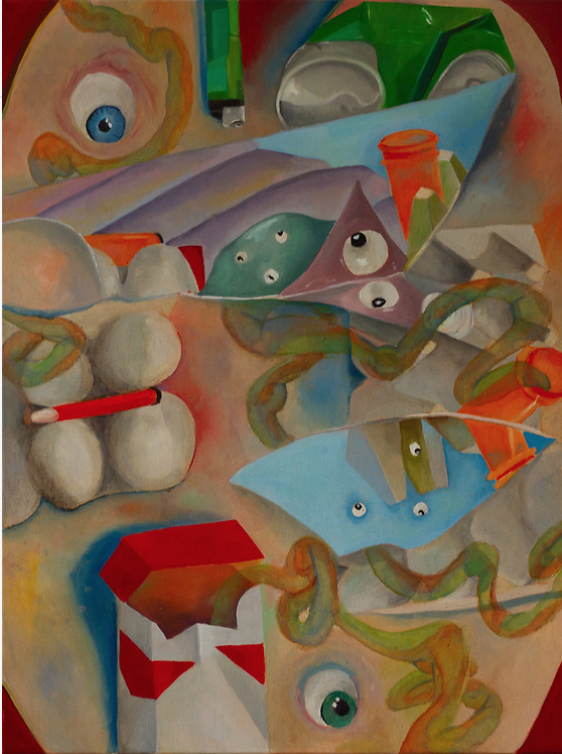
You get what you give
Kennedy B. Haney
Oil on canvas
2020
24" x 18"
Artist Statement
Male bower birds are known for the nests they build out of flashy objects they collect to attract a mate. My work serves to bring attention to the casually discarded objects found in the environment. The subject of my pieces is commercial products and packaging rendered in a simplified manner to focus on the relationships of the shapes to one another. The still-lives reference litter and debris and give them anthropomorphic qualities. By valuing the relationship between humans and nature, and the work represents how one shapes another. The foundation of my work originates with my awareness of the trash on the streets. Sometimes I collect items to render them from life in paintings or to use them in collage work. Collecting items and rendering them from life in paintings as collage- I juxtapose materials to convey an implied message. Oil paint is often combined with mixed media collage, sculpture, and ceramics to test the boundaries of materials by placing them in a new context. Like the bower bird, I want the objects to be seen as beautiful and enticing even though they are trash. The pieces take a substance that is purposefully ignored and make it seen. The work seduces the viewer to look at the stuff with a fresh perspective and allows them to revel in the debris. My vision for the work is to help people become more mindful in their consumption and disposal of objects, and of its impact on nature.
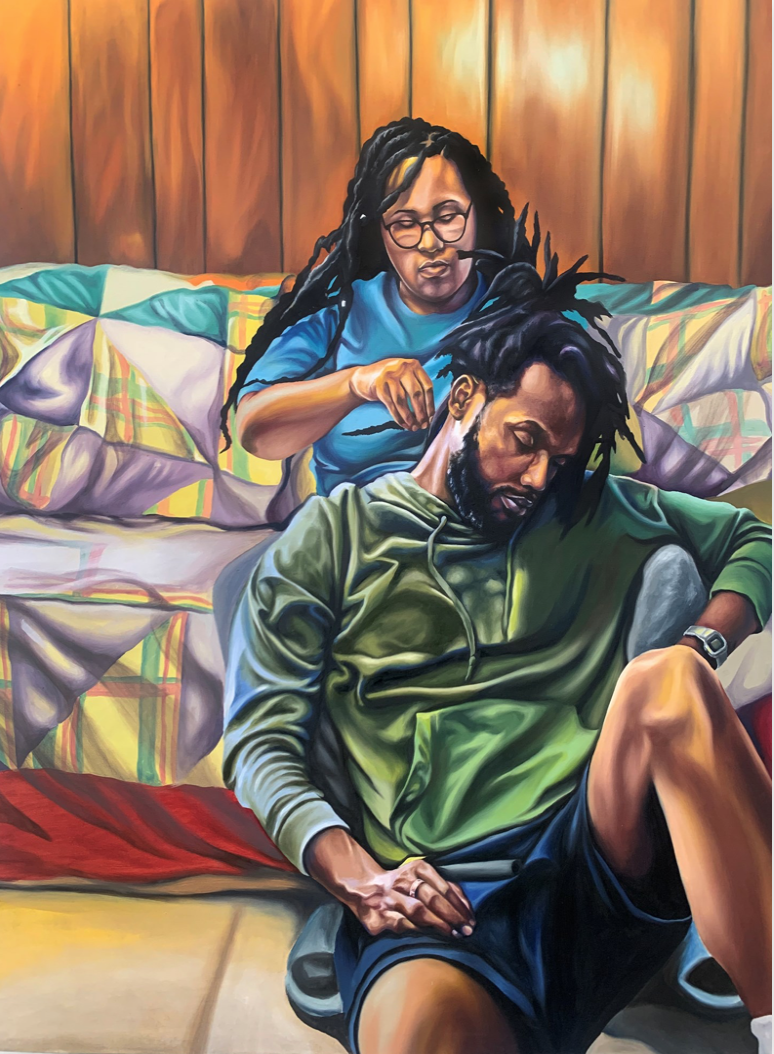
A Woman's Touch
Richard Echols
Oil on canvas
2021
60" x 48" x 1"
Artist Statement
(statement continued from entry 1) As an African American man from Memphis, TN, I have a genuine interest in everyday people in my community and highlighting their ways of life through my work. I use my art to promote a positive narrative of my community to combat the negative stereotypes oftentimes portrayed through various forms of media. The visual qualities of my artwork can be described as narrative paintings that depict African American figures interacting within a diverse range of environments. This thoughtful representation is important for me because contemporary art needs to see black representation to bring forth cultural awareness. One of my main inspirations comes from classical paintings and how they used this form of art to document people of stature. Unfortunately, paintings of that time do not highlight individuals of color, and diverse backgrounds, so the goal of my work is to draw inspiration from the classical era and diversify it. The juxtaposition of historical and new references is why my work fits within the current space of contemporary art. For example, in the painting “After a Long Day”, I highlighted a black man sitting on a red leather couch with a beer nearby seemingly reflecting on life. While this depiction may seem obvious, there is much more to consider than that. The important elements of this painting are his slouched posture and weathered skin and hands, which ultimately represents the psychology of the subject. Leisure time in the African American community can oftentimes feel like a luxury rather than a necessity, due to the many years that black and brown communities have been expected to perform physical labor. This painting affords the viewer the opportunity to experience the subject’s moment of reflection and embrace the subject’s moment of stillness. In conclusion, art making serves as more than just a means of making something beautiful. (continued on entry 2)
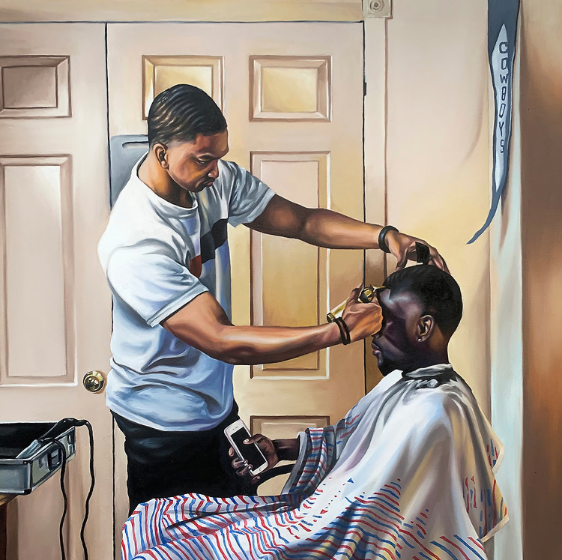
Stay Still
Richard Echols
Oil on canvas
2021
36" x 36" x 1"
Artist Statement
(statement continued from entry 1) For example, in the painting “After a Long Day”, I highlighted a black man sitting on a red leather couch with a beer nearby seemingly reflecting on life. While this depiction may seem obvious, there is much more to consider than that. The important elements of this painting are his slouched posture and weathered skin and hands, which ultimately represents the psychology of the subject. Leisure time in the African American community can oftentimes feel like a luxury rather than a necessity, due to the many years that black and brown communities have been expected to perform physical labor. This painting affords the viewer the opportunity to experience the subject’s moment of reflection and embrace the subject’s moment of stillness. In conclusion, art making serves as more than just a means of making something beautiful. I believe it is my duty as an artist to create work that challenges the assumptions of the viewer. The number one question I want viewers of my work to walk away with is why these people are important enough to be immortalized through my work.